Triumph Daytona 955i
|
| |
| Manufacturer | Triumph |
|---|---|
| Also called | Triumph T595 Daytona (1997–1998) |
| Production | 1997–2006 |
| Class | Sport bike |
| Engine |
955 cc (58.3 cu in) 4-stroke, inline-3 4 valve per cylinder DOHC, liquid-cooled |
| Bore / stroke |
79.0 mm × 65.0 mm (3.11 in × 2.56 in) Compression ratio: 12.0:1 |
| Transmission | 6 gears |
| Frame type | Cast aluminium |
| Suspension |
Front: 45 mm (1.8 in) forks with dual rate springs and adjustable preload, compression and rebound damping |
| Brakes |
Front: Double disc. 4-piston callipers. 320 mm (13 in) |
| Tyres | Front: 120 / 70 ZR 17, Rear: 190 / 50 ZR 17 |
| Wheelbase | 1,426 mm (56.1 in) |
| Dimensions |
L: 2,112 mm (83.1 in) W: 725 mm (28.5 in) H: 1,165 mm (45.9 in) |
| Seat height | 815 mm (32.1 in) |
| Fuel capacity | 21 l (4.6 imp gal; 5.5 US gal) |
| Related |
Triumph Daytona 600 Triumph Speed Triple Triumph Daytona 675 |
The Triumph Daytona 955i is a sport bike manufactured by Triumph from 1997 to 2006. It was powered by a 955 cc (58.3 cu in) liquid cooled, inline three four stroke engine. The bike was launched in 1997 as the Triumph T595 Daytona and renamed Triumph Daytona 955i in 1999.
History
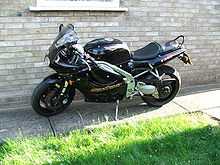
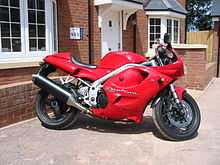
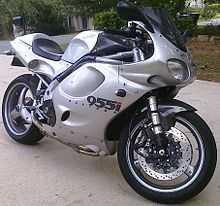
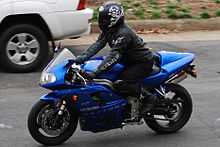
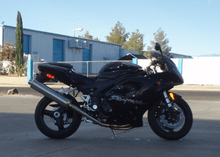
The Triumph Daytona T595 was introduced in 1997 in an attempt by Triumph to tap into the sports bike market. Despite the T595 name, the bike featured a 955 cc displacement in-line three-cylinder engine designed in part by Lotus. Along with the other triple-cylinder Triumphs, the Daytona helped to establish the newly managed manufacturer and its distinctive and unique three-cylinder motorcycles.
The T595-model name concatenated the new engine series "T5" and the first two numbers of the "955 cc" displacement. In 1999 the bike was renamed 955i because the T595 model name gave the impression that the bike's engine displaced 595 cc.
Large-scale changes were made in 2002, with a complete restyling of the bodywork by designer Gareth Davies, a newly designed engine raising the horsepower to 149 with internal performance upgrades included Forged steel crankshaft, forged steel connecting rods, and forged aluminium pistons. Focused on reducing weight and better handling, the 2002 955i used a more common double-sided swing arm (DSSA) as opposed to the single-sided swing arm (SSSA) of the previous Daytonas. The DSSA version weighs 7.5 pounds (3.4 kg) less than the SSSA due to the lighter weight swing arm, and it is argued that the DSSA version handles better than the SSSA as it has less flex in the swing arm. The 2002+ 955i version had a more compact and advanced Sagem MC1000 electronic engine management system (2-plug) instead of the original Sagem MC2000 controller (1-plug).
In 2002, a limited-production Centennial Edition (CE) Daytona 955i was offered. The 955i CE had several noteworthy additions to and differences from the non-CE '02 DSSA Daytona 955i:
- One colour option of Aston (British Racing) Green, which was offered only on the 2002 955i Centennial Edition.
- Carbon fibre infill panels between the fuel tank and tail fairing.
- Carbon fibre infill panels between the fuel tank and front fairing.
- Single-sided swing arm (like the previous and later Daytona 955i).
In 2002 a limited-production Special Edition (SE) Daytona 955i was offered. The 955i SE model similar to the CE, except with red body work and the deletion of the centennial logos.
In 2004, some minor changes were made including the deletion of the Union Jack logos.
In 2005 the bodywork was revised to include a horizontally-split headlamp, a more streamlined upper fairing, and a reduced tail 'hump'. The frame was also painted black instead of the silver of all previous models. The fuel-injection system was changed from a bypass-regulated-rail to a returnless-rail system.
The post-2002 Daytona 955i never gained the popularity of the earlier T595 and pre-2002 955i. Only on the outer borders of the Super Sport market when it was first released in 1997, it was considered more of a Sport Touring motorcycle, rather than a full Super Sport by 2006 when production was discontinued.
Specifications
| 1999–2001 | 2002–2006 | ||
|---|---|---|---|
| Engine | |||
| Type | Liquid Cooled, In-Line 3-Cylinder | ||
| Capacity | 955 cc (58.3 cu in) | ||
| Bore/Stroke | 79.0 mm × 65.0 mm (3.11 in × 2.56 in) | ||
| Compression Ratio | 11.2:1 | 12.0:1 | |
| Fuel System | Sequential multipoint electronic fuel injection. DOHC | ||
| Ignition | CDI via electronic engine management system | ||
| Transmission | |||
| Primary Drive | Gear | ||
| Final Drive | X-ring Chain | O-ring Chain | |
| Clutch | Wet, multi-plate | ||
| Gearbox | 6 speed | ||
| Cycle Parts | |||
| Frame | Fabricated cast aluminium alloy perimeter | ||
| Swingarm | Single-sided, aluminium alloy with eccentric chain adjuster | ||
| Front Wheel | Alloy 3-spoke, 17 in × 3.5 in (432 mm × 89 mm) | ||
| Rear Wheel | Alloy 3-spoke, 17 in × 6.0 in (430 mm × 150 mm) | ||
| Front Tire | 120/70-ZR17 | ||
| Rear Tire | 190/50-ZR17 | ||
| Front Suspension | 45 mm conventional forks with dual rate springs and adjustable preload, compression and rebound damping | ||
| Rear Suspension | Monoshock with adjustable preload, rebound and compression damping | ||
| Front Brakes | Double disc. 4-piston callipers. 320 mm (12.6 in) | ||
| Rear Brakes | Single disc. 2-piston callipers. 220 mm (8.7 in) diameter. | ||
| Dimensions | |||
| Length | 2,115 mm (83.3 in) | 2,112 mm (83.1 in) | |
| Width | 720 mm (28.3 in) | 725 mm (28.5 in) | |
| Height | 1,170 mm (46.1 in) | 1,165 mm (45.9 in) | |
| Seat Height | 800 mm (31.5 in) | 815 mm (32.1 in) | |
| Wheelbase | 1,431 mm (56.3 in) | 1,426 mm (56.1 in) | |
| Rake/Trail | 24 / 86 mm | ||
| Fuel Tank Capacity | 18 litres (4.0 imp gal; 4.8 US gal) | 21 litres (4.6 imp gal; 5.5 US gal) | |